1997 CHEVROLET CORVETTE service
[x] Cancel search: servicePage 266 of 356
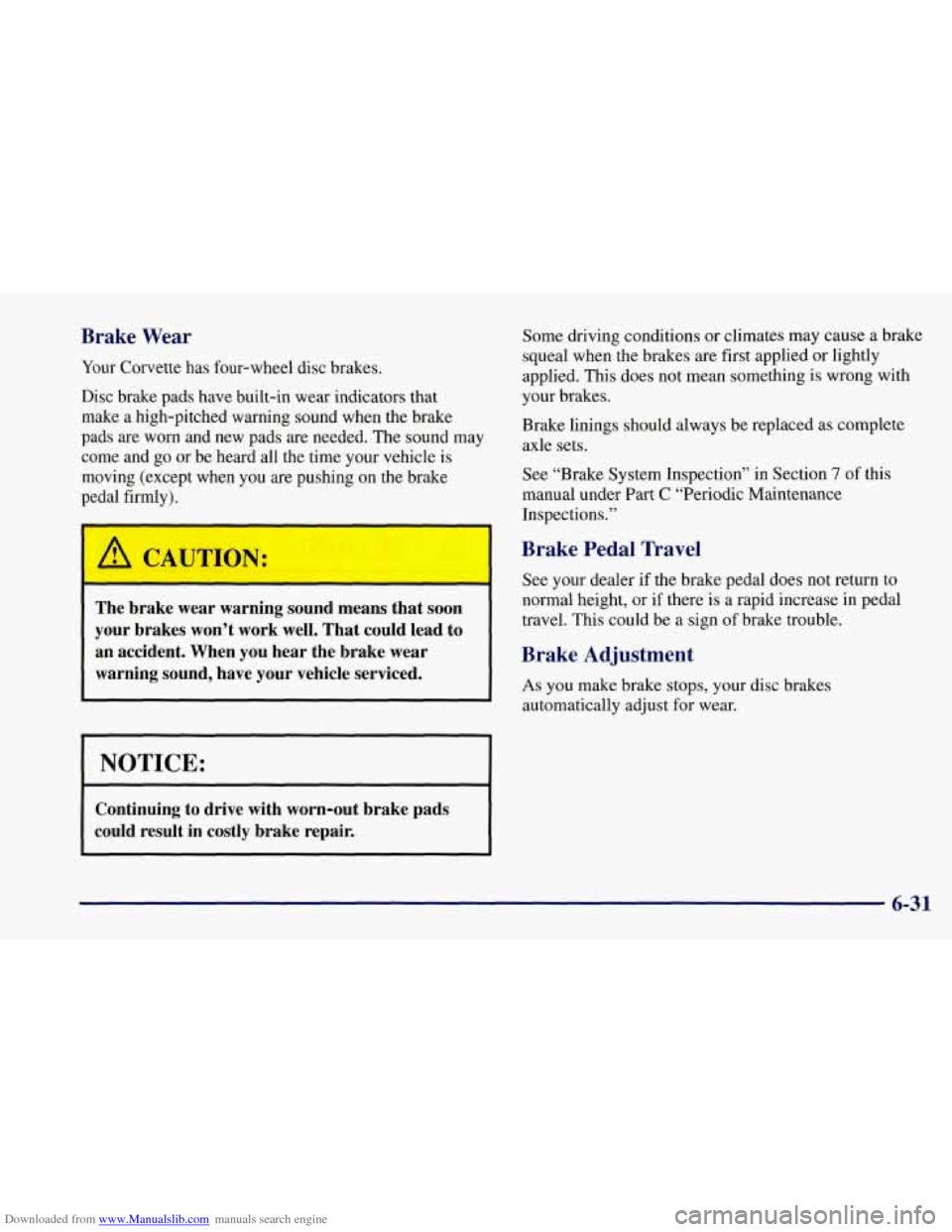
Downloaded from www.Manualslib.com manuals search engine Brake Wear
Your Corvette has four-wheel disc brakes.
Disc brake pads have built-in wear indicators that
make a high-pitched warning sound when the brake
pads are worn and new pads are needed. The sound may
come and go or be heard all the time your vehicle is
moving (except when you
are pushing on the brake
pedal firmly).
The brake wear warning sound means that soon
your brakes won’t work well. That could lead
to
an accident. When you hear the brake wear
warning sound, have your vehicle serviced.
NOTICE:
Continuing to drive with worn-out brake pads
could result in costly brake repair.
Some driving conditions or climates may cause a brake
squeal when the brakes are first applied or lightly
applied. This does not mean something is wrong with
your brakes.
Brake linings should always be replaced as complete
axle sets.
See “Brake System Inspection” in Section
7 of this
manual under Part
C “Periodic Maintenance
Inspections.”
Brake Pedal Travel
See your dealer if the brake pedal does not return to
normal height, or if there is a rapid increase in pedal
travel. This could be a sign of brake trouble.
Brake Adjustment
As you make brake stops, your disc brakes
automatically adjust for wear.
6-31
Page 267 of 356
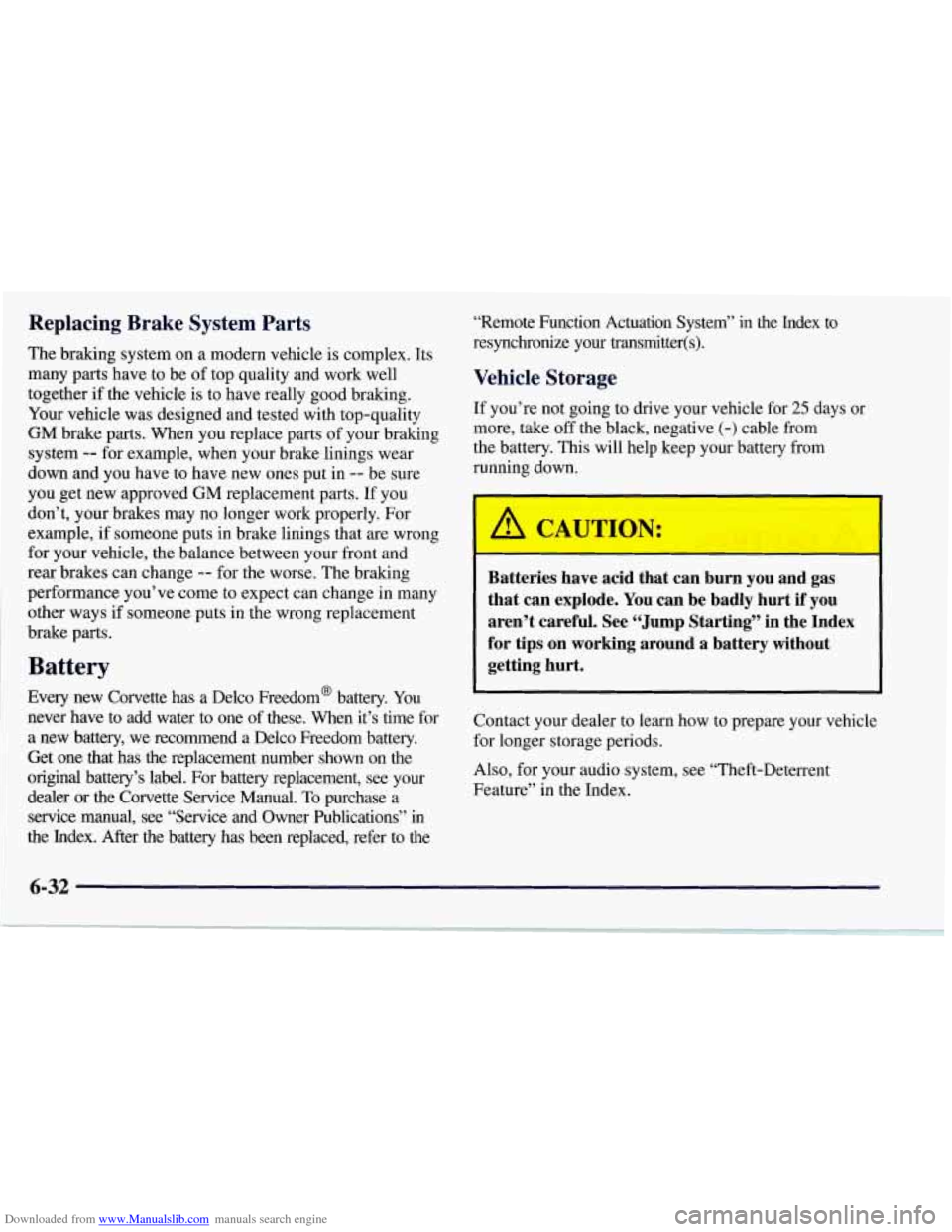
Downloaded from www.Manualslib.com manuals search engine Replacing Brake System Parts
The braking system on a modern vehicle is complex. Its
many parts have to be of top quality and work well
together if the vehicle is to have really good braking.
Your vehicle was designed and tested with top-quality
GM brake parts. When you replace parts of your braking
system
-- for example, when your brake linings wear
down and you have to have new ones put
in -- be sure
you get new approved GM replacement parts. If you
don’t, your brakes may no longer work properly. For
example, if someone puts in brake linings that
are wrong
for your vehicle, the balance between your front and
rear brakes can change
-- for the worse. The braking
performance you’ve come to expect can change in many
other ways if someone puts in the wrong replacement
brake parts.
Battery
Every new Corvette has a Delco Freedom@ battery. You
never have to add water to one of these. When it’s time for
a new battery, we recommend a Delco Freedom battery.
Get one that has the replacement number shown on the
original battery’s label. For battery replacement, see your
dealer or the Corvette Service Manual. To purchase
a
service manual, see “Service and Owner Publications” in
the Index. After the battery has been replaced, refer to the “Remote Function Actuation System” in
the Index to
resynchronize your transmitter(s).
Vehicle Storage
If you’re not going to drive your vehicle for 25 days or
more, take
off the black, negative (-) cable from
the battery.
This will help keep your battery from
running down.
Batteries have acid that can burn you and gas
that can explode. You can be badly hurt
if you
aren’t careful. See “Jump Starting” in the Index
for tips
on working around a battery without
getting hurt.
Contact your dealer to learn how to prepare your vehicle
for longer storage periods.
Also, for your audio system, see “Theft-Deterrent
Feature” in the Index.
6-32
Page 275 of 356
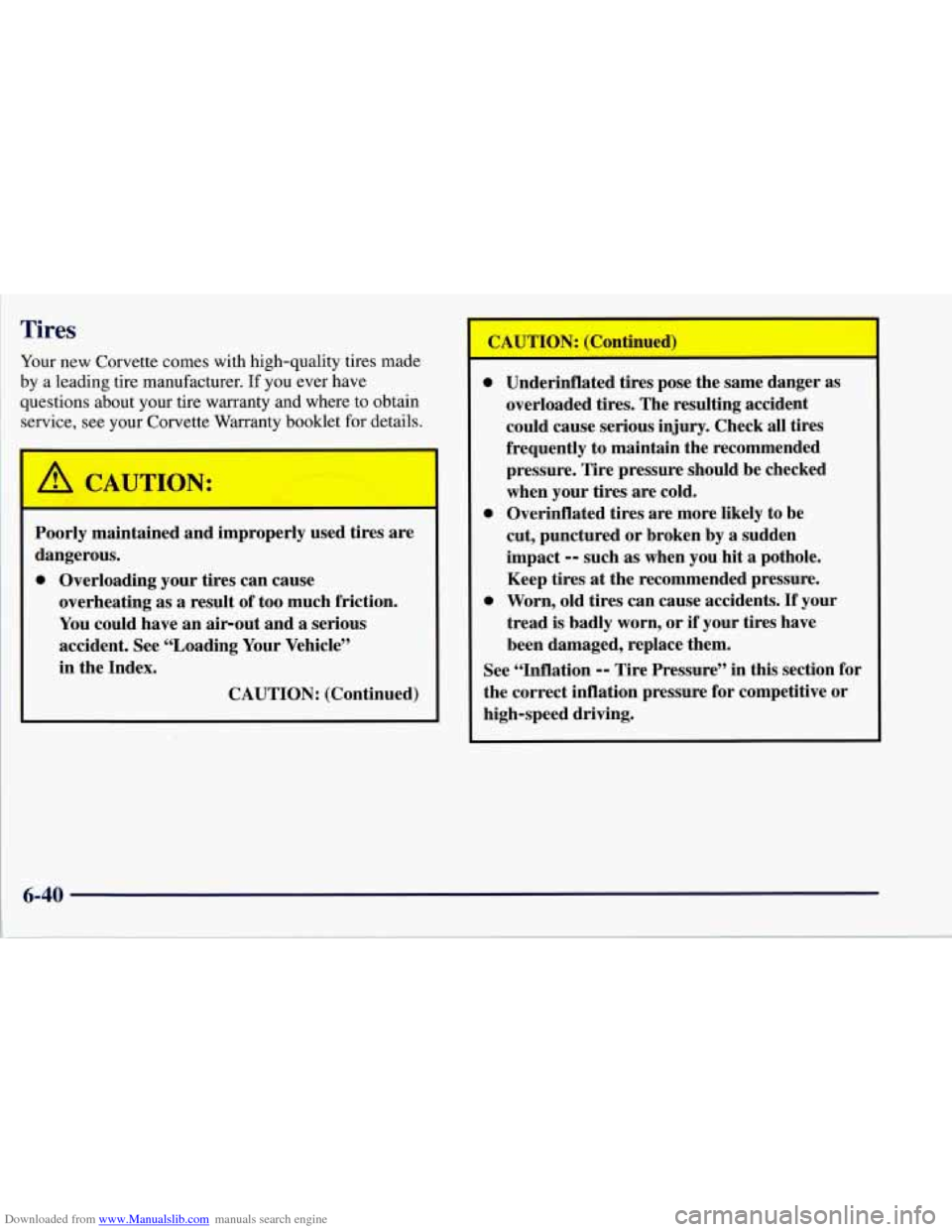
Downloaded from www.Manualslib.com manuals search engine Tires
Your new Corvette comes with high-quality tires made
by a leading tire manufacturer. If you ever have
questions about your tire warranty and where to obtain
service, see your Corvette Warranty booklet for details.
Poorly maintained and improperly used tires are
dangerous.
0 Overloading your tires can cause
overheating as a result of too much friction.
You could have an air-out and a serious
accident. See “Loading Your Vehicle”
in the Index.
CAUTION: (Continued)
0
0
0
See “Inflation
Underinflated tires
pose the same danger as
overloaded tires. The resulting accident could cause serious injury. Check all tires
frequently to maintain the recommended
pressure. Tire pressure should be checked
when your tires are cold.
Overinflated tires are more likely to be
cut, punctured or broken by a sudden
impact
-- such as when you hit a pothole.
Keep tires
at the recommended pressure.
Worn, old tires can cause accidents.
If your
tread is badly worn, or if your tires have
been damaged, replace them.
-- Tire Pressure” in this section
the correct inflation pressure for competitive or
high-speed driving.
Page 276 of 356
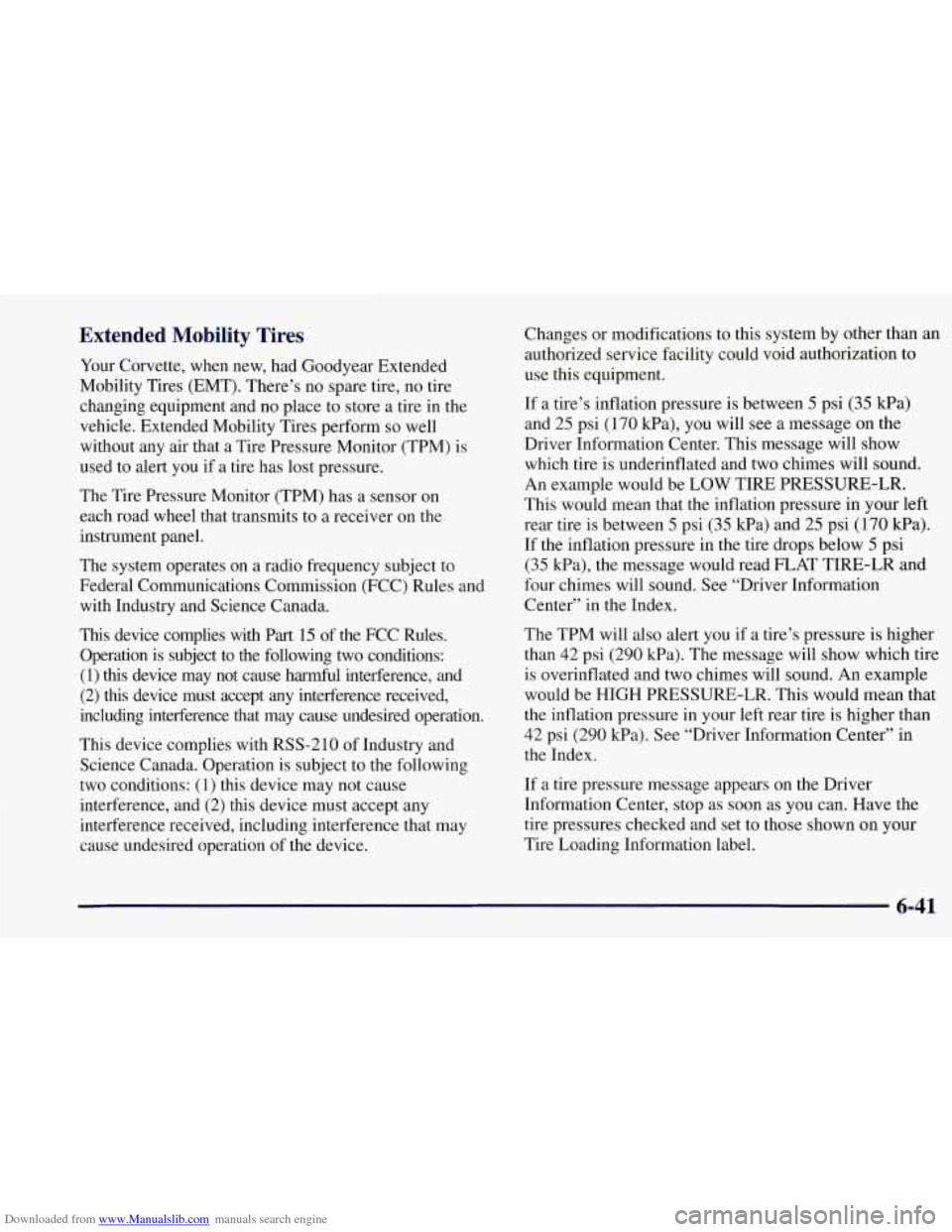
Downloaded from www.Manualslib.com manuals search engine Extended Mobility Tires
Your Corvette, when new, had Goodyear Extended
Mobility Tires (EMT). There’s no spare tire, no tire
changing equipment and no place to store a tire in the
vehicle. Extended Mobility Tires perform
so well
without any air that a Tire Pressure Monitor (TPM) is
used to alert you if a tire has lost pressure.
The Tire Pressure Monitor (TPM) has a sensor on
each road wheel that transmits to a receiver on the
instrument panel.
The system operates on a radio frequency subject to
Federal Communications Commission (FCC) Rules and with Industry and Science Canada.
This device complies with Part 15 of the FCC Rules.
Operation is subject to the following two conditions:
(1)
this device may not cause harmful interference, and
(2) this device must accept any interference received,
including interference that may cause undesired operation.
This device complies with RSS-210 of Industry and
Science Canada. Operation is subject to the following
two conditions:
(1) this device may not cause
interference, and (2) this device must accept any
interference received, including interference that may
cause undesired operation of the device. Changes
or modifications to this system by other than an
authorized service facility could void authorization to
use this equipment.
If a tire’s inflation pressure is between
5 psi (35 kPa)
and 25 psi
(170 kPa), you will see a message on the
Driver Information Center. This message will show
which tire is underinflated and two chimes will sound.
An example would be LOW TIRE PRESSURE-LR.
This would mean that the inflation pressure in your left
rear tire is between
5 psi (35 Pa) and 25 psi (170 Wa).
If the inflation pressure in the tire drops below
5 psi
(35 kPa), the message would read FLAT TIRE-LR and
four chimes will sound. See “Driver Information
Center” in the Index.
The TPM will also alert you if a tire’s pressure is higher
than 42 psi (290 kPa). The message will show which tire
is overinflated and two chimes will sound. An example
would be
HIGH PRESSURE-LR. This would mean that
the inflation pressure in your left rear tire is higher than
42 psi
(290 Wa). See “Driver Information Center” in
the Index.
If a tire pressure message appears
on the Driver
Information Center, stop as soon as you can. Have the
tire pressures checked and set to those shown on your
Tire Loading Information label.
6-41
Page 277 of 356
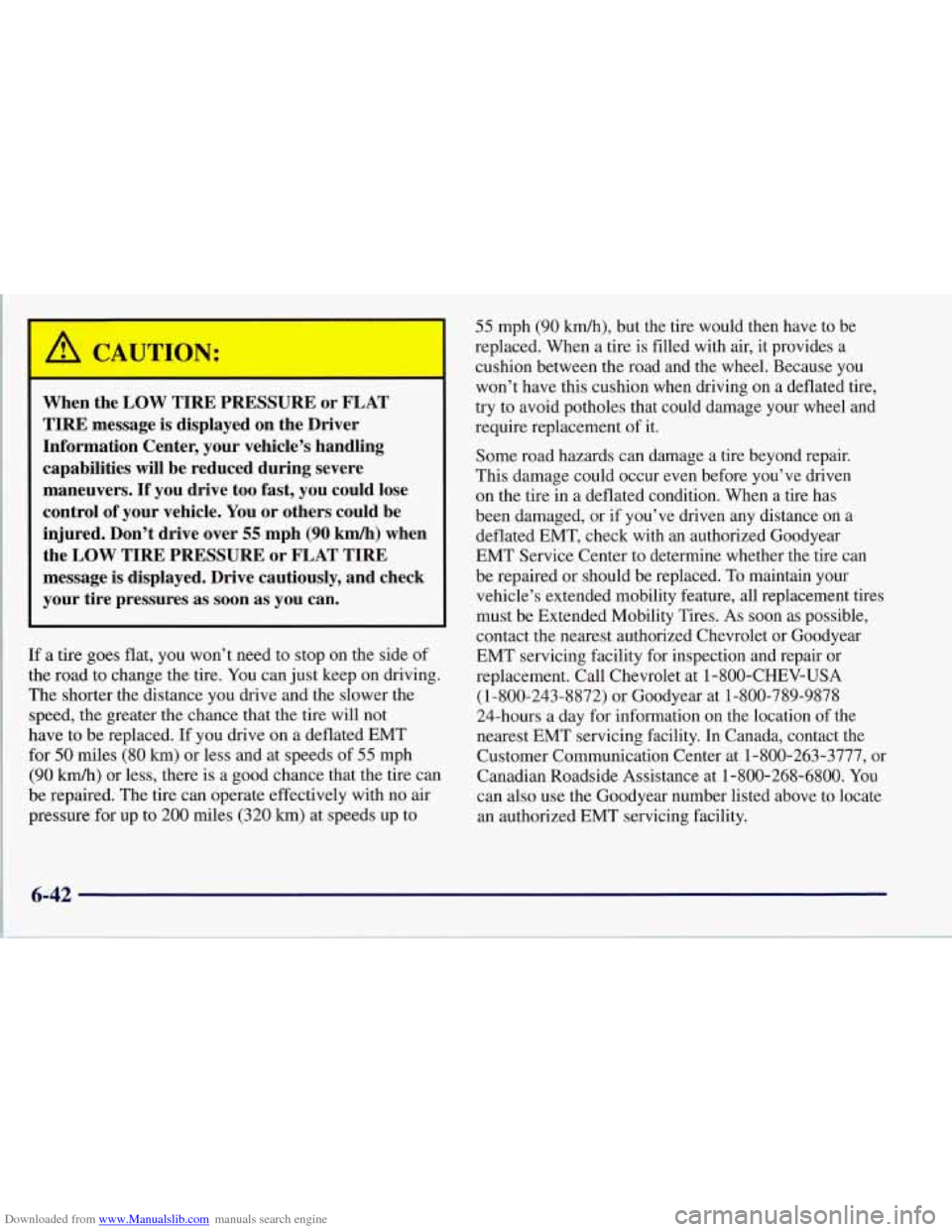
Downloaded from www.Manualslib.com manuals search engine I
9 CAUTION:
When the LOW TIRE PRESSURE or FLAT TIRE message is displayed on the Driver
Information Center, your vehicle’s handling
capabilities
will be reduced during severe
maneuvers. If you drive too fast, you could lose
control
of your vehicle. You or others could be
injured. Don’t drive over
55 mph (90 km/h) when
the LOW TIRE PRESSURE or FLAT TIRE
message is displayed. Drive cautiously, and check
your tire pressures as soon as you can.
If a tire goes flat, you won’t need to stop on the side of
the road to change the tire.
You can just keep on driving.
The shorter the distance you drive and the slower the
speed, the greater the chance that the tire will not
have to be replaced.
If you drive on a deflated EMT
for
50 miles (80 km) or less and at speeds of 55 mph
(90 km/h) or less, there is a good chance that the tire can
be repaired. The tire can operate effectively with no air
pressure for up to 200 miles (320
km) at speeds up to
55 mph (90 kdh), but the tire would then have to be
replaced. When a tire is filled with air,
it provides a
cushion between the road and the wheel. Because you
won’t have this cushion when driving on a deflated tire,
try to avoid potholes that could damage your wheel and
require replacement of it.
Some road hazards can damage a tire beyond repair.
This damage could occur even before you’ve driven
on the tire in a deflated condition. When a tire has
been damaged, or if you’ve driven any distance on
a
deflated EMT, check with an authorized Goodyear
EMT Service Center to determine whether the tire can
be repaired or should be replaced. To maintain your
vehicle’s extended mobility feature, all replacement tires
must be Extended Mobility Tires.
As soon as possible,
contact the nearest authorized Chevrolet or Goodyear
EMT servicing facility for inspection and repair or
replacement. Call Chevrolet at 1-800-CHEV-USA
(1-800-243-8872) or Goodyear at 1-800-789-9878
24-hours a day for information on the location of the
nearest EMT servicing facility. In Canada, contact the
Customer Communication Center at 1-800-263-3777, or
Canadian Roadside Assistance at 1-800-268-6800. You
can also use the Goodyear number listed above to locate
an authorized EMT servicing facility.
Page 278 of 356
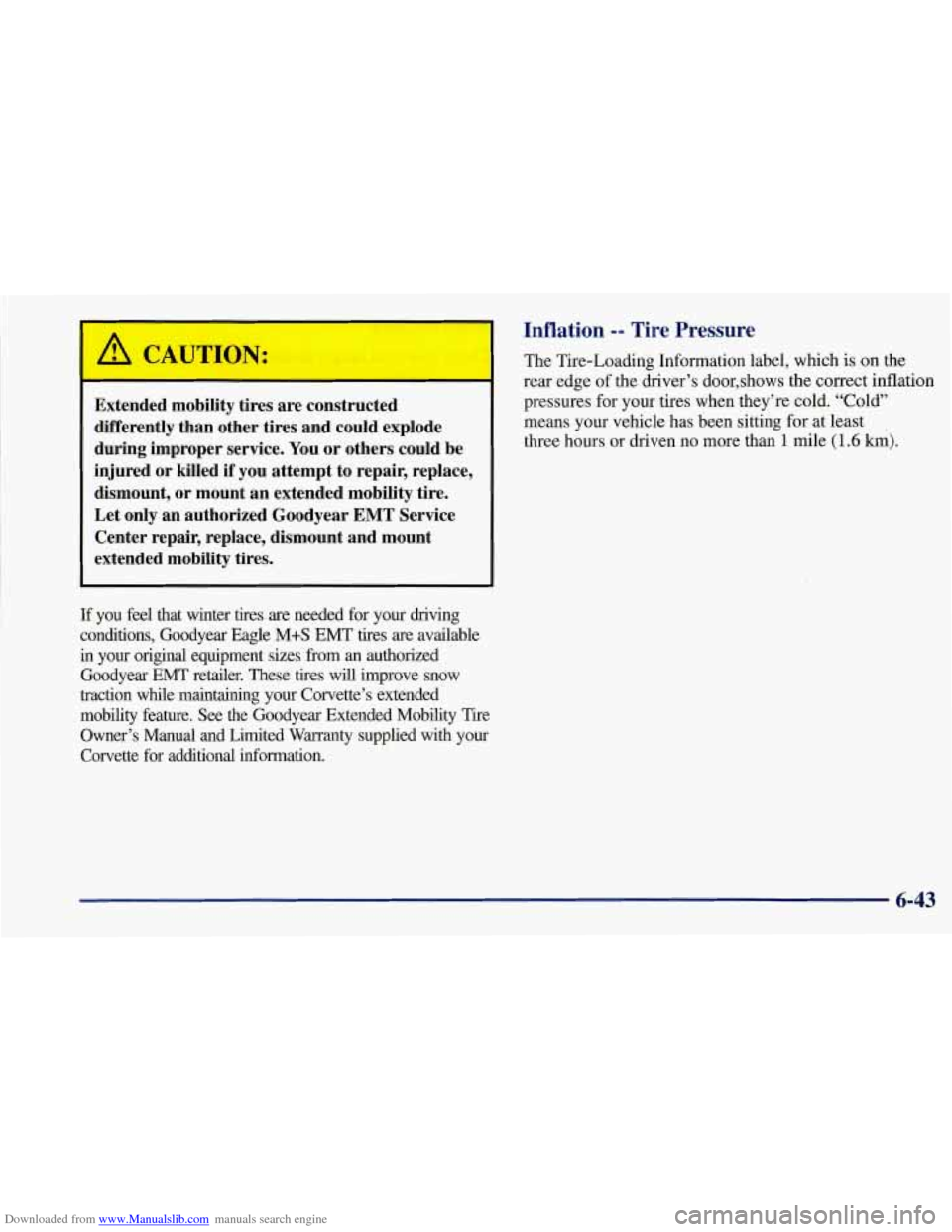
Downloaded from www.Manualslib.com manuals search engine Extended mobility tires are constructed
differently than other tires and could explode
during improper service. You or others could be
injured or killed
if you attempt to repair, replace,
dismount,
or mount an extended mobility tire.
Let only an authorized Goodyear
EMT Service
Center repair, replace, dismount and mount
extended mobility tires.
If you feel that winter tires are needed for your driving
conditions, Goodyear Eagle
M+S EMT tires are available
in your original equipment sizes fi-om an authorized
Goodyear EMT retailer. These tires will improve snow traction while maintaining your Corvette’s extended
mobility feature. See
the Goodyear Extended Mobility Tire
Owner’s Manual and Limited Warranty supplied with your
Corvette for additional information.
Inflation -- Tire Pressure
The Tire-Loading Information label, which is on the
rear edge
of the driver’s door,shows the correct inflation
pressures for
your tires when they’re cold. “Cold”
means your vehicle has been sitting for at least
three hours
or driven no more than 1 mile (1.6 km).
6-43
Page 280 of 356
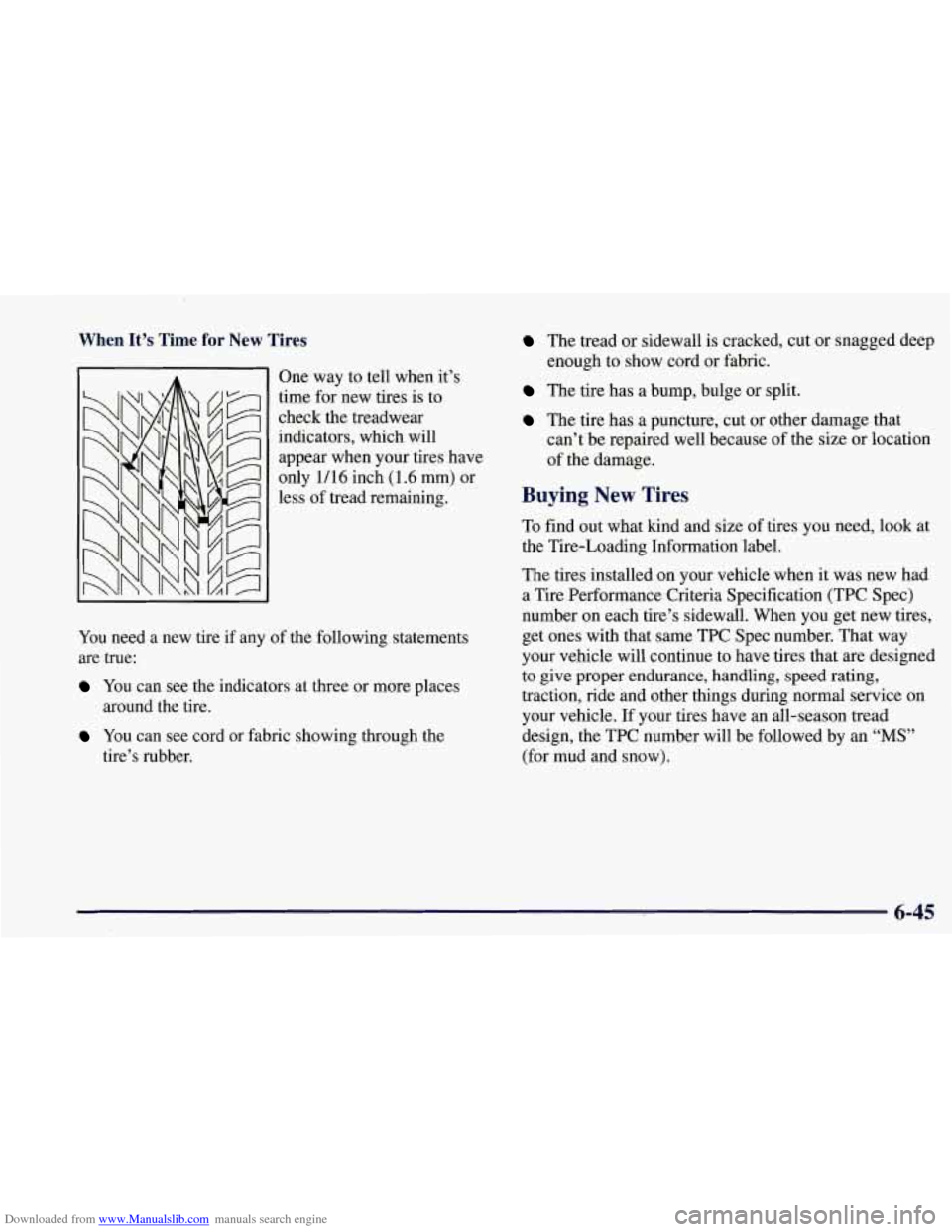
Downloaded from www.Manualslib.com manuals search engine When It’s Time for New Tires
One way to tell when it’s
time for new tires is to
check the treadwear
indicators, which will
appear when your tires have
only 1/16 inch (1.6 mm) or
less of tread remaining.
You need
a new tire if any of the following statements
are true:
You can see the indicators at three or more places
You can see cord or fabric showing through the
around the tire.
tire’s rubber.
The tread or sidewall is cracked, cut or snagged deep
enough to show cord or fabric.
The tire has a bump, bulge or split.
The tire has a puncture, cut or other damage that
can’t be repaired well because of the size or location
of the damage.
Buying New Tires
To find out what kind and size of tires you need, look at
the Tire-Loading Information label.
The tires installed on your vehicle when it was new had
a Tire Performance Criteria Specification (TPC Spec)
number on each tire’s sidewall. When you get new tires,
get ones with that same TPC Spec number. That way
your vehicle will continue to have tires that are designed
to give proper endurance, handling, speed rating,
traction, ride and other things during normal service on
your vehicle.
If your tires have an all-season tread
design, the TPC number will be followed by an
“MS”
(for mud and snow).
6-45
Page 282 of 356
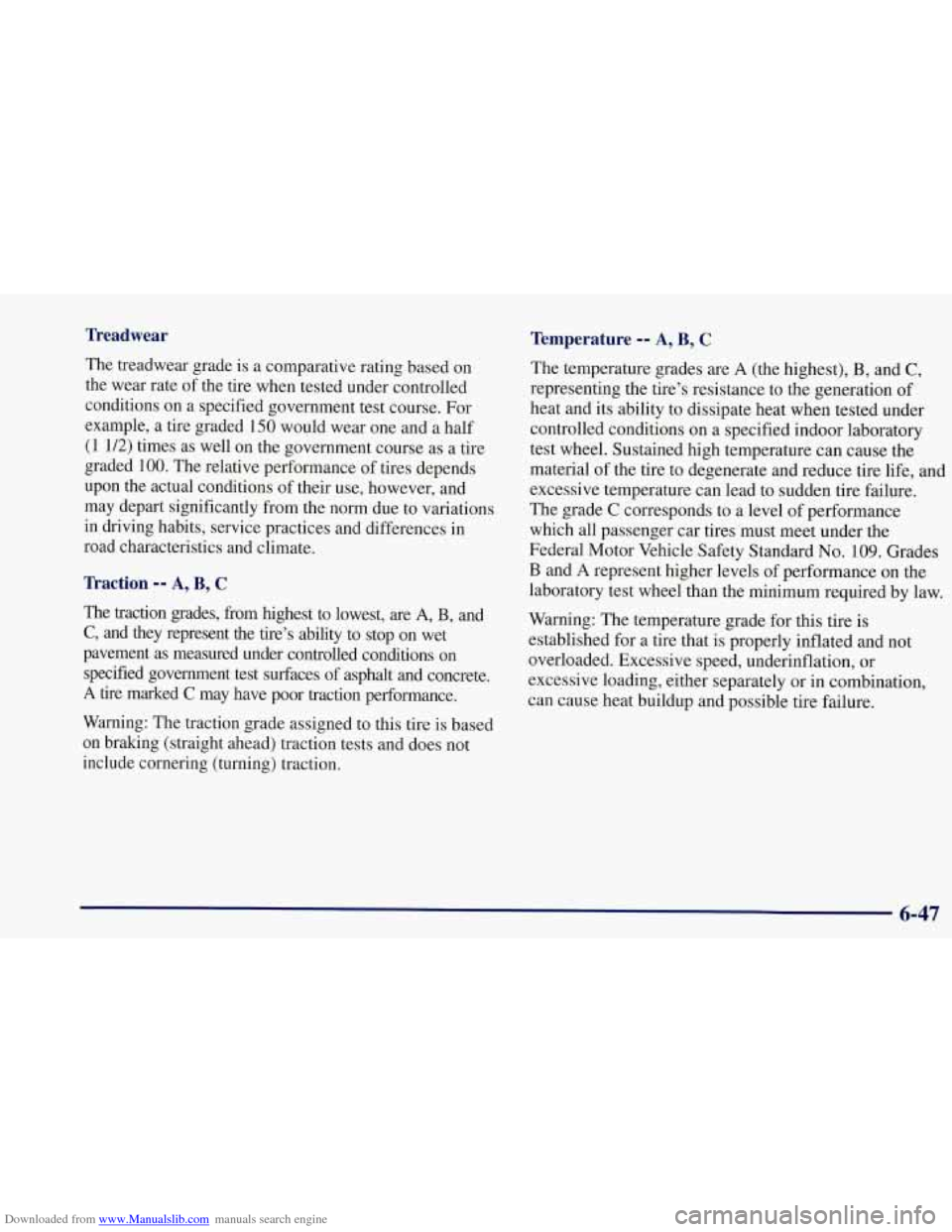
Downloaded from www.Manualslib.com manuals search engine Treadwear Temperature -- A, B, C
The treadwear grade is a comparative rating based on
the wear rate of the tire when tested under controlled
conditions on a specified government test course. For
example, a tire graded
150 would wear one and a half
(1 1/2) times as well on the government course as a tire
graded
100. The relative performance of tires depends
upon the actual conditions of their use, however, and
may depart significantly from the norm due to variations
in driving habits, service practices and differences
in
road characteristics and climate.
Tkaction -- A, B, C
The traction grades, from highest to lowest, are A, B, and
C, and they represent the tire’s ability to stop on wet
pavement as measured under controlled conditions on specified government test surfaces of asphalt and concrete.
A tire marked C may have poor traction performance.
Warning: The traction grade assigned to this tire is based
on bralung (straight ahead) traction tests and does not
include cornering (turning) traction. The
temperature grades are
A (the highest), B, and C,
representing the tire’s resistance to the generation of
heat and its ability to dissipate heat when tested under
controlled conditions on a specified indoor laboratory
test wheel. Sustained high temperature can cause the
material of the tire to degenerate and reduce tire life, and
excessive temperature can lead to sudden tire failure.
The grade
C corresponds to a level of performance
which all passenger car tires must meet under the
Federal Motor Vehicle Safety Standard
No. 109. Grades
B and A represent higher levels of performance on the
laboratory test wheel than the minimum required by law.
Warning: The temperature grade for this tire is
established for a tire that is properly inflated and not
overloaded. Excessive speed, underinflation, or
excessive loading, either separately or in combination,
can cause heat buildup and possible tire failure.
6-47